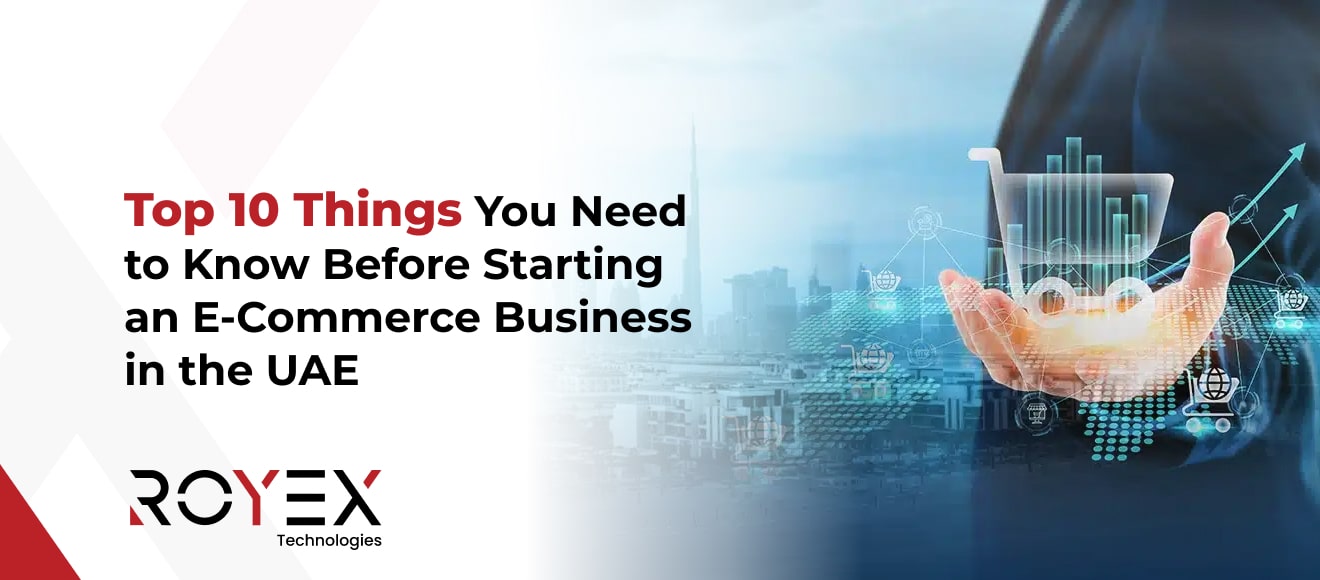
Top 10 Things You Need to Know Before Starting an E-Commerce Business in the UAE
The UAE is one of the most dynamic e-commerce markets in the MENA region — offering strong growth opportunities, but also raising the bar on execution. According to a report by EZDubai (in partnership with Euromonitor International), the UAE’s e-commerce market reached around AED 32.3 billion (USD 8.8 billion) in 2024 and is projected to exceed AED 50.6 billion (USD 13.8 billion) by 2029.
Key implications:
-
You’re entering a large and growing pie, so there’s demand.
-
But growth also means competition, higher consumer expectations, and higher cost structures (logistics, returns, payments).
-
Consumer profile: younger, digitally fluent, mobile-first, comfortable with online payments and expecting fast delivery.
What you should do:
-
Quantify the reachable market for your niche (geography, category, demographic) rather than assuming “the UAE market” equals everyone.
-
Understand your ideal customer: age, language (English + Arabic), device use, payment preferences (card, digital wallet, BNPL).
-
Use growth projections (CAGR ~9.4% from 2024-29 for UAE) to build your business plan. Zawya
2. Licensing, Compliance & Legal Structures
Starting an e-commerce business in the UAE isn’t just about building a website — it involves legal, regulatory and compliance considerations that significantly impact speed to market and operating costs.
Important dimensions:
-
Company registration and e-commerce licence requirements (onshore or free zone).
-
VAT registration (UAE is 5% standard VAT) and understanding tax implications on cross-border orders.
-
Data protection and consumer-rights law compliance: ensuring your website, terms of service, returns-policy, privacy policy align with UAE norms.
-
Payment gateway compliance: local acquiring banks, digital wallet integrations, anti-fraud protections.
-
Import duties and customs if you source internationally.
Why this matters:
Failing to account for legal/licensing delays means you can launch late, incur fines or face blocked payment gateways — all of which eats cash.
What you should do:
-
Secure your business licence early and confirm permitted activity (online retail) and region (UAE-wide or specific emirate).
-
Integrate VAT and duties into your cost model.
-
Choose a payment gateway that supports AED, local wallets, and has good fraud controls for UAE market.
3. Platform, Technology & Mobile-First UX
With high smartphone penetration and mobile usage in the UAE, your tech stack and UX are foundational to success. Some key stats: in Dubai, more than 75% of all online shopping is done via smartphones. Global E-Com Leaders 500
Core technology questions:
-
Should you choose a SaaS platform (Shopify, BigCommerce), open-source (WooCommerce, Magento) or fully custom build?
-
Mobile-first design: fast page loads, responsive design, minimal friction in checkout.
-
Language support: English and Arabic version of the website is often required to serve the local and expat population.
-
Payment & checkout flows: guest checkout, express pay options, local wallets, BNPL.
-
Speed, reliability & security: slow load times kill conversions; security problems kill trust.
What you should do: -
Benchmark mobile performance (load time <3 s ideally) and conversion rate differences mobile vs desktop.
-
Choose a platform that can scale as you grow (traffic spikes, add-ons, integrations).
-
Localize your UX: Arabic language option, localized content, regionally relevant shipping/payment options.
-
Build an analytics and event-tracking plan from day one (session recordings, funnel drop-off, device metrics).
4. Product Selection, Sourcing & Inventory Strategy
The products you sell and how you source them are critical to both margin and differentiation.
Key considerations:
-
Niche vs broad catalogue: A niche allows specialization, better margins, less competition; broad catalogue can scale faster but requires heavier inventory & logistics.
-
Local trends: In the UAE the top categories by value in 2024 were apparel & footwear, consumer electronics and home care. Media-Avataar Mena+1
-
Sourcing: Local vs international; the landed cost (manufacturing/sourcing cost + shipping + duties + customs) needs to be accurate in your cost model.
-
Inventory strategy: Pre-stock vs dropshipping vs hybrid; each has trade-offs (cash & risk, margin, fulfillment time).
-
SKU rationalization: Avoid too many slow-moving SKUs early; focus on high-turn, high-margin products.
What you should do: -
Map your product margins clearly (COGS, shipping to UAE, duties, local storage).
-
Calculate your AOV (average order value) and project how many orders per month you need to be viable.
-
Consider local warehousing or hybrid fulfilment if high shipping costs are impacting margins.
-
Plan for inventory lead-times (especially if sourcing internationally) and buffer for peak periods (sales, holidays).
5. Fulfilment, Logistics & Reverse-Flow (Returns)
One of the most overlooked cost centres in UAE e-commerce is logistics and returns. Consumer expectations are increasingly high: fast delivery, free shipping thresholds, easy returns.
Key facts:
-
Free delivery and free returns are major drivers of consumer loyalty in the UAE. Zawya
-
Logistics cost is higher in the UAE compared to many markets because of geography, small parcel sizes, multiple emirates, and cross-border imports.
-
Returns rates in categories like apparel can be high (20 %+ globally) and local returns infrastructure (inspection, restocking, resell) adds invisible cost.
What you should do: -
Build a realistic shipping cost model (last-mile courier cost, regional differences, cash on delivery surcharges if used).
-
Set free shipping thresholds that help increase AOV to offset cost.
-
Build a returns policy and process that is user-friendly but economically viable (restocking fee? resale plan?).
-
Choose 3PL partners that understand UAE e-commerce and can offer real SLAs, tracking, and integration with your platform.
-
Monitor fulfilment KPIs: shipment delay rate, delivery success rate, return ratio by SKU.
6. Payment Methods, Fraud & Currency Management
In the UAE, payment mechanisms and fraud control are major determinants of your conversion rate, cost of sale and trust with customers.
Important dimensions:
-
Payment methods: Credit/debit cards still dominate but digital wallets are growing rapidly (from 41 % in 2020 to 53 % in 2024 in the UAE). Media-Avataar Mena+1
-
Buy-Now‐Pay-Later (BNPL) options: Growing adoption among younger consumers; offers flexibility but needs margin and risk factored in.
-
Fraud, chargebacks & disputes: International sourcing and COD (cash on delivery) models increase risk.
-
Currency & settlement: If you sell internationally or import, exchange rates and settlement fees matter.
What you should do: -
Offer local payment methods (UAE-based wallets, local bank gateways) and ensure AED pricing.
-
Monitor conversion rate by payment method and drop-off in payment screen.
-
Assess payment provider fees (transaction % + monthly) and choose partners with strong fraud detection.
-
Factor bad-debt and returns into your cost model.
-
Ensure your checkout is seamless and supports preferred payment flows (wallets, installments, credit).
7. Customer Acquisition & Retention (Marketing Strategy)
It’s one thing to build the store and logistics; it’s another to drive traffic, convert it, and retain customers. Many lesser-successful e-commerce ventures spend all their budget on acquisition and neglect retention, which is costly.
Important dynamics:
-
Cost of acquisition (CAC) is rising globally and in the UAE — you must track it vs value of customer (LTV).
-
Owned channels (email, SMS, app push) often deliver higher ROI than paid ads but are under-utilised.
-
Social commerce and influencer marketing are gaining traction in the UAE, especially with a younger demographic.
-
Content and SEO: With competitive marketing spend, organic channels offer sustainable growth if executed well.
What you should do: -
Build a marketing mix: paid search/ social + organic SEO + influencer/affiliate + email/SMS lifecycle flows.
-
Set clear targets: CAC ≤ LTV/3 often used as rule-of-thumb.
-
Invest early in customer retention: welcome flow, post-purchase series, loyalty rewards, subscription models.
-
Track key marketing metrics: CR (conversion rate), AOV (average order value), repeat purchase rate, CAC, LTV, ROAS (return on ad spend).
-
Build content that resonates locally (Arabic copy, culturally relevant visuals, region-specific promotions).
8. Localization: Language, Culture & Consumer Behaviour
The UAE is a multicultural, bilingual market with both local Emirati consumers and large expat communities. Localization is not optional.
Key considerations:
-
Language: English + Arabic versions of site and communications increase reach and credibility.
-
Cultural understanding: Payment timing, shipping expectations, return comfort, preferred communication channel (WhatsApp is widely used).
-
Device usage: High smartphone usage, but among lower-income consumers or certain demographics desktop/laptop may still matter.
-
Local holidays & events: UAE has its own consumer calendar (Ramadan, Dubai Shopping Festival, National Day) which affect demand and seasonality.
What you should do: -
Provide Arabic UI, copy, customer support.
-
Use payment flows familiar to local consumers (wallets, installments).
-
Tailor visuals and messaging to regional tastes (not just Western templates).
-
Plan promotions around local events and adapt your logistics to seasonal spikes.
-
Test mobile vs desktop behaviour specifically for your user segments.
9. Data & Analytics: Build Measurement Before You Scale
Many e-commerce failures stem from lack of measurement and delayed course-correction. A thought-leadership mindset means investing early in data, and using it to guide decisions.
Key metrics to capture:
-
Sessions by channel, device, geography
-
Conversion by device (mobile vs desktop)
-
Checkout funnel drop-off (add to cart → begin checkout → payment)
-
Average order value (AOV)
-
Customer Acquisition Cost (CAC) by channel
-
Customer Lifetime Value (LTV) and repeat purchase rate
-
Return rate by SKU
-
Fulfilment cost per order
Some relevant stats: cart abandonment globally ranges ~70–80 %. Your UAE store may face similar levels, so tracking where drop-off occurs is essential.
What you should do: -
Implement analytics tracking (GA4 or equivalent), e-commerce events, UTM tagging.
-
Build dashboards (weekly/monthly) that show traffic → conversion → revenue → margin.
-
Before scaling marketing spend, ensure you know your unit economics (CAC, margin, return rate, fulfilment cost).
-
Use A/B testing on product pages, checkout flow, mobile layout.
-
Set up alerting for anomalies (e.g., sudden drop in conversion, shipping delays spike).
10. Cash-Flow, Scale & Exit Strategy
Finally, thinking like a leader means not just about launch and growth, but sustainability, scale and eventual exit or continued growth.
Important themes:
-
Cash-flow management: Inventory, marketing spend, returns and logistics all tie up cash.
-
Scalability: Your platform, logistics, supplier relationships must scale as you grow traffic and order volume.
-
Margins: Aggressive discounting or free shipping offers can reduce margin, so you need clear unit economics.
-
Exit possibilities: Whether you plan to build for sale, merge, or long-term growth, setting fundamentals early matters (data, brand, customer base, repeat rate).
What you should do: -
Build a cash-flow model for at least 12 months, factoring inventory cycles and returns.
-
Plan for scale: select suppliers and logistics partners that grow with you.
-
Define margin targets and monitor them monthly — aim not just for growth, but healthy profit.
-
Capture customer data and build brand equity early, which enhances value for any future exit or growth step.
Why Choose Royex for E-Commerce Development
When you’re aiming to build a high-performing e-commerce business in the UAE — not just a transactional site — you need a partner who understands the nuance of the local market, the technology demands, and the operational and measurement rigour required. That’s where Royex Technologies comes in.
What Royex brings to the table:
-
Local-market expertise: Royex knows UAE consumer behaviour, preferred payment and shipping flows, Arabic/English UX requirements and marketplace dynamics.
-
Performance-first technology: Mobile-first, speed-optimized platforms, checkout flows customized for UAE payment methods and device mix.
-
Scalable architecture: The platform is built to grow — whether you’re starting niche or planning multi-SKU and multi-emirate scale.
-
Data & analytics foundation: From day one, Royex sets up tracking, dashboards and measurement so you can manage unit economics and growth.
-
End-to-end ecosystem: From front-end UX, platform integration, payment and shipping setup, through to analytics and marketing enablement.
-
Focus on ROI, not just launch: Royex helps you think beyond “get the site live” to “get the site profitable, scalable & sustainable.”
If you aim to launch a credible, competitive e-commerce business in the UAE — one that’s built for growth, data-driven, and contextualized for local reality — Royex is the partner that understands both the strategy and execution required.
stablished in 2013, Royex Technologies is a leading E-Commerce Web Design Company in Dubai that provides innovative solutions for small, medium, and large-scale companies. We specialize in responsive web development, mobile app development, CRM integration, AI solutions for website & mobile applications, and many more. Our extensive experience in mobile app development will help you to take your business to a high level.
Conclusion
Entering e-commerce in the UAE offers tremendous promise, but it’s a market that demands operational excellence, data discipline, localization and scale awareness. By understanding market size and consumer profiles, legal/compliance realities, tech and UX expectations, sourcing and logistics complexity, payment ecosystem, customer acquisition and retention, localization, data measurement and cash-flow/exit strategy — you set yourself up for success.
Use the ten points above as your strategic blueprint. If you partner with the right team (like Royex) and build with both ambition and rigor, you will not just launch — you will scale, compete and thrive in the UAE’s evolving online commerce economy.





